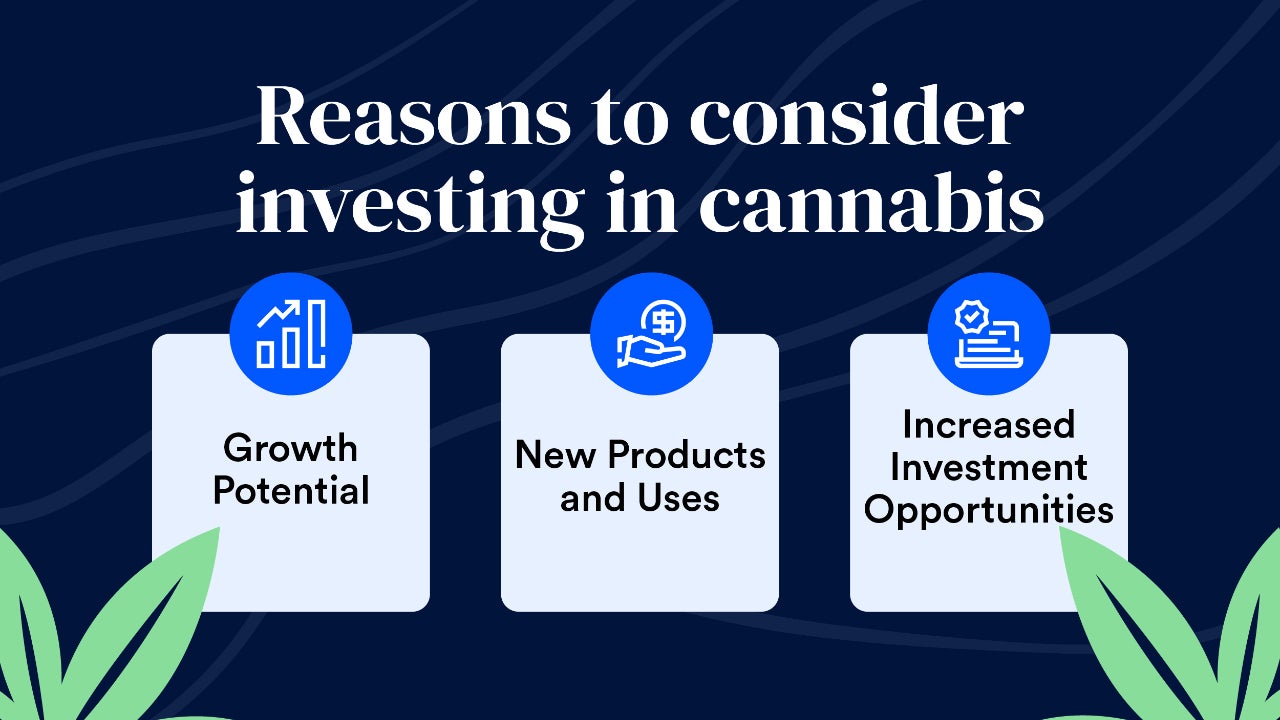Investing in marijuana: A beginner’s guide to cannabis stocks and funds

As marijuana continues to expand the number of places where it is legal, some investors are excited about the profit potential for the cannabis industry. Total legal cannabis sales are expected to grow more than 16 percent a year and reach $51 billion in 2025, according to cannabis research firm New Frontier Data. Medical benefits and the growing use of products tied to cannabidiol, or CBD, make the cannabis industry ripe for continued growth.
While still illegal at the federal level, many states have moved to legalize marijuana in recent years, with the drug being fully legal in 18 states and Washington, D.C. as of 2022. California was the first state to legalize medical marijuana in 1996, while Colorado and Washington became the first states to legalize recreational use of the drug in 2012.
Further legalization makes the growth potential enticing, but there are risks to watch out for. Here are some key things to consider before investing in cannabis.
Fast facts on the growth of the cannabis industry:
- Global legal cannabis sales are expected to reach $51 billion in 2025, according to New Frontier Data.
- Total illegal global cannabis sales are expected to reach $445.3 billion in 2025, according to New Frontier Data.
- In 2022, total legal cannabis sales for medical use is estimated to be $14.7 billion globally. Legal cannabis sales for adult use are estimated to be $22 billion globally.
- In a 2021 poll, 68 percent of Americans supported legalizing marijuana, according to Gallup, matching a record-high reached in 2020.
- 37 states and the District of Columbia allow for medical marijuana use, according to the National Conference of State Legislatures. Of those, 18 states and the District of Columbia allow non-medical use.
Reasons to consider investing in cannabis
Any investment in a company or industry will ultimately depend on the profits those companies are able to deliver to shareholders. The cannabis industry is no different, but there are some reasons to be excited if you’re a potential investor.
- Growth potential: The cannabis industry is still relatively young, with many states only just recently legalizing the drug. This leaves plenty of room for future growth that could come from further legalization, possibly at the federal level, and a wider adoption of products and uses.
- New products and uses: Many people have an outdated image in their head when it comes to marijuana, but new products are being developed constantly. The drug’s effectiveness is currently being studied in treating conditions such as Alzheimer’s, Crohn’s disease and certain forms of cancer. CBD-related products have also grown in popularity in recent years, with consumers purchasing items such as CBD oils, beverages and even chewing gum.
- May find investment gems early: As companies work to innovate in the fast-changing industry, investment opportunities will be created for those willing to do some research. While there are risks associated with fast-growing industries, the opportunities created can outweigh those concerns.

How to invest in the cannabis industry
Once you’ve decided whether investing in the cannabis industry makes sense for you, there are a few different ways to actually invest — many of which are accessible through your preferred online broker or favorite investment app.
Cannabis stocks
One way to participate in the cannabis industry is by purchasing the stock of companies with ties to marijuana. Cresco Labs (CRLBF) is involved in growing, manufacturing and distributing cannabis-related products for consumers and currently operates in 10 states. But potential investors should be aware that the company failed to generate net income for shareholders in each of the past three years. The stock trades over-the-counter, or OTC, which means it will be less liquid than major stocks that trade on large exchanges.
Tilray (TLRY) is another company that sells consumer products related to cannabis as well as hemp-based foods and alcoholic beverages. The company, which trades on the Nasdaq, has a current market value of about $2.3 billion, but generated a net loss in each of its last three fiscal years.
Curaleaf Holdings (CURLF) and Green Thumb Industries (GTII.CN) are two other stocks in the cannabis industry that are relatively large, with each carrying market values around $4 billion, but Curaleaf trades OTC and Green Thumb trades in Canada.
Cannabis ETFs
ETFs are another way to invest in the cannabis industry without having to pick individual companies, but be careful not to pay too much in fees.
One of the most popular cannabis ETFs is the ETFMG Alternative Harvest ETF (MJ), which holds shares in about 37 companies and is designed to track the performance of companies within the cannabis ecosystem. As of May 2022, the fund’s largest positions were in Canopy Growth Corp. (CGC) and Tilray (TLRY), with those two holdings making up about 14 percent of the fund’s assets. Investors in the ETF will pay an annual expense ratio of 0.75 percent, significantly higher than what a typical stock index fund would charge.
Another option is the Horizons U.S. Marijuana Index ETF (HMUS.NE), which began trading in April 2019. This ETF holds shares in U.S. companies and comes with a hefty expense ratio of 0.85 percent. It tracks the performance of the U.S. Marijuana Companies Index, but the ETF trades in Canada and is therefore quoted in Canadian dollars. It’s relatively small with about CA$15 million in assets as of May 2022.
Cannabis REITs
Because marijuana is still illegal at the federal level, most banks are unable or unwilling to provide financing to the cannabis industry. As companies in the industry look to raise funds, many are turning to non-traditional sources such as real estate investment trusts, or REITs. Cannabis companies are able to engage in certain types of deals, such as a sale-leaseback transaction, where they sell their real estate to a REIT and immediately lease it back at an agreed upon price. This is one way for companies to get capital outside traditional banking.
Innovative Industrial Properties (IIPR) is one of the best-known cannabis REITs and focuses exclusively on medical uses of marijuana. It holds a portfolio of greenhouse buildings that are leased to medical-use growers across major U.S. markets. It offers investors a yield above 5 percent as of May 2022.
Risks of investing in cannabis
While the growth potential of the cannabis industry may sound exciting, there are some key risks to keep in mind.
- Legal/regulations: Although the trend has been toward more legalization, it is important to remember that the drug is still illegal at the federal level, which makes it difficult for companies in the cannabis industry to raise money through traditional banks, which are federally regulated. The laws can vary from state to state and may swing based on which political party is in power. In places where it’s legal, high tax rates on sales and other costly regulations can make profitability difficult for companies.
- Increased competition: The growth potential of the industry attracts a lot of companies and entrepreneurs looking to capitalize on a booming industry. But that also means it will be very competitive, which could impact the return on investment earned by shareholders. Just because an industry is poised for growth doesn’t mean that shareholders will benefit. Airlines generated losses for decades despite delivering enormous innovation to the general public.
- Early days: The industry is still quite young and just beginning to develop. Many companies have yet to earn a profit, but promise great future returns to shareholders. While the potential is there for gains, keep in mind that investors only benefit if there ultimately are future profits to be divided up.
Bottom line
The cannabis industry is likely to continue to grow in the coming years and investors may look to benefit from that growth through stock ownership or ETFs that track the industry. But remember that innovation doesn’t always lead to profits for shareholders and high-fee ETFs can eat into your ultimate return.
Editorial Disclaimer: All investors are advised to conduct their own independent research into investment strategies before making an investment decision. In addition, investors are advised that past investment product performance is no guarantee of future price appreciation.






